
Collecting
LITHUANIAN FIREARMS
(Last updated 9/05/08)


Collecting
LITHUANIAN FIREARMS
(Last updated 9/05/08)

Introduction
Unfortunately, very little has been published on the subject of historic
Lithuanian firearms. This page represents an effort to change this.
It is not at present meant to be an authoritative source, but rather a
growing repository of information on the subject. The reader is invited
to remit comments on the veracity of the following content, and of course,
offer new information and/or photographs. This informational resource
would not have been possible without the generous contributions of time
and data from other Lithuanian firearm collectors.
1919-1940 (Lithuania's Independence and the Struggle to Maintain It)
Perhaps one of the rarest nationality of weapon contracts of the era, Lithuanian contract firearms seem to be far more rarely encountered than those of the other Baltic nations. The prevalence of Baltic contract firearms would seem to be a function of which forces captured the arms at the onset of World War II. For example, a significant number of Estonian rifles used against the Germans eventually ended up being surrendered to the Allies in Czechoslovakia and other western theaters. A great many Lithuanian firearms, however, were captured by the Russians and disappeared behind the Iron Curtain for almost fifty years. These were used heavily and traded many times over to various countries, rather than being preserved in the hands of collectors.
A specific example of this is one of the rifles pictured on page 164 of Robert W. D. Ball's Mauser Military Rifles of the World . The depicted FN Model 30 Short Rifle has Chinese markings, having been in the arsenals of Lithuania, Russia, China, and possibly also Germany and Korea as a result of captures and arms trades. Ball even suggests that some Lithuanian rifles were "captured by the Germans, then by the Russians, who supplied them from storage to the Viet Cong, from whom they were captured by the Americans!" The level of wear on these rifles is often considerable. Photos of a Lithuanian rifle, also evidently used by China at some point, can be seen here .
The author has personally examined one Lithuanian FN Model 30 Short
Rifle with a cracked handguard, apparently arsenal-repaired
with a staple . This repair is physically effective, despite its obvious
aesthetic drawbacks. The rifle was one of three accidentally imported with
a batch of German 98k's (and mistakenly importer-stamped as such!) from
Romania. These rifles were captured by Germany and given to Romania
during World War II. The type of repair evident on this rifle is
perhaps less surprising when one envisions a Romanian armory with hundreds
or thousands of 98k's, and three oddball Lithuanian FN30's with completely
distinct parts. When something broke on an FN Model 30, replacement
was a far less viable option than if the weapon were one of the many 98k's.
RIFLES
Immediately after gaining independence, the new Lithuanian army's standard weapon stocks included leftover Model 1891 Mosin-Nagants, German Model 1898 Mausers, [9 ] and Enfield rifles supplied to the Italians in WWI and then sold to Lithuania in 1924 (along with a large supply of .303 caliber ammo). The Mosin Nagants and British Enfields were relegated to police, national guard, and reserve units because of a desire to standardize ammunition for the rifles supplied to primary units. The Enfields were later traded in as part of the arrangements for purchasing Belgian FN carbines. [5 ] As time passed, new rifles were purchased for the army under contract.
Known Lithuanian Rifle Contracts and Markings
It has been suggested that the Lithuanian army purchased the following rifles:
I have heard reports of four varieties of receiver ring markings on the Lithuanian FN:A 1919 photo indicates that Lithuania also ended up with German Gewehr 98's and K-98's, Russian Mosin Nagants, and even Japanese Arisakas! The German and Russian guns may have been bring-backs from Lithuanians who abandoned the crumbling Russian and German armies in 1917 and 1919, respectively. One might guess that the Japanese Arisakas were bring-backs from the Russian Army (which purchased 760,000 Arisakas from Japan and England; see [ 2] ) or direct purchases by Lithuania from one of the aforementioned countries. It is known that Finland gave 10,000 Arisakas to Estonian freedom fighters. The Lithuanian army used British WWI-era Enfield rifles. Captured weapons were only given Lithuanian markings if they were sent to the arsenal for repairs (and then, only the repaired piece was stamped).1. Intertwined script "FN" inside a circle, with "Mod. 24 L."
Gaidis believes that there may have been an even earlier variety with the script "FN" but without the "Mod" marking. This variety would be limited to a few test pieces used before any large orders were placed. These probably came from existing stock.
2. Pillars of Gediminas with "24 L." below:
3. "GINKLU FONDAS", "1937" over the Pillars of Gediminas, and " L" below. [1 ]
4. "GINKLU FONDAS" over the Pillars of Gediminas, and "24 L" below. No date.[5]
Note: "GINKLU FONDAS", meaning "arms fund", is a term still associated with the Lithuanian military today. Weapons so-marked were paid for by cash donations from the civilian population, not tax revenue.
Lithuanian proof marks (Pillars of Gediminas) also appear on various parts on some rifles, including the top of the front of the triggerguard assembly (visible only when the rifle is disassembled), the trigger, the lower receiver above the trigger (likewise visible only when the rifle is disassembled), the top of the bolt handle, the front barrel band/bayonet lug, the rear sight base, and the back of the bottom of the rear sight. Note that some markings may be partial due to imperfect stamping. A Lithuanian Army Officer was assigned to the FN factory for quality assurance purposes, which may have something to do with the extent to which so many individual parts were stamped. (Thanks to Ed (mauserdad) for the detail photos!)
Note: Kevin Carney (of North China Arms) mentioned in an email that he has encountered a Lithuanian Ezensast (sp?) Mosin Nagant
1891 that came out of Bulgaria. The relevant marking appears on the underside of the stock, just forward of the trigger guard:
(Click on photo for closeup.)
More information on these is desired.
Supposedly, black-painted Lithuanian FN Model 30's exist that were refurbished
by France and sold. See http://www.geocities.com/Yosemite/Meadows/7162/danR.htm
Historic Photos
British Pattern 14 (P14) "Enfield" rifle
Lithuanian machine gun unit armed with British P14 rifles
Lithuanian soldier armed with a British P14 rifle
Lithuanian soldiers practice firing their British P14 rifles in a 1931 summer training exercise
Members of the 1st Infantry Regiment fire at targets during a training exercise; note the P14 bayonets worn on the belts of the nearest soldiers
FN rifle
A Lithuanian soldier armed with an FN Model 30 rifle tends to his dog near a snowy forest
A Lithuanian soldier shouldering an FN Model 30 rifle
A member of the 1st Infantry Regiment practices marksmanship, with officers in background
A rack of FN Model 30 rifles in the barracks of the 1st Infantry Regiment
A Lithuanian machine gun squad armed with a Russian M1910 Maxim machine gun, FN and German Mauser rifles
A Lithuanian machine gun squad poses with a Browning machine gun and FN rifles
German M1898 Mauser rifle
A Lithuanian soldier poses with a German M1898 rifle
A Lithuanian training poster for the German 98k Mauser rifle
A Lithuanian machine gun squad armed with a Russian M1910 Maxim machine gun, FN and German Mauser rifles
Additional photographic references for the FN rifle:
Two different Lithuanian FN Short Model 30's and a Lithuanian vz 24
appear on page 158 of Ball's Mauser Military Rifles of
the World .
A color photo of one of the FN Short Model 30's appears on page 164
of the same reference.
Bayonets
A 15 inch Lithuanian-marked bayonet (apparently a cross between the
Belgian and Czech models, with the cutting edge down, but with a lug like
the FN and 3 distinct Pillars of Gediminas stamps) has been recorded [
6 ], as have standard FN export bayonets (finished in the white with
a single Pillars of Gediminas stamp) [5] . Neither
bayonet version has any manufacturer's markings on it.
Modern Rifles
Lithuania was given 200 M16A1 rifles by the US on 7/7/1997. On 1/9/1998, Lithuania received 40,000 M14 rifles (from the US again), along with 500,000 rounds of 7.62mm blank ammunition and 1,500,000 7.62mm ball ammunition. They also received a few thousand anti-tank rifles. See http://www.fas.org/asmp/profiles/worldtable.html for more details. Also see this photo of Major General Kronkaitis, the former Commander in Chief, holding one of the 40,000 M14s.
It seems quite likely that Lithuania ended up with AK-47's at some point
in the recent past. It has been established that a Lithuanian weapons designer has created the "Vytis-1", which looks like a small AK-47. I will post photos of this soon.
MACHINE GUNS
Lithuania purchased Vickers machine guns (Class 'E', 'F' and 'C/T' guns in "reasonable quantities") during this period. Its military forces also reportedly used the CZ-made 7.92mm ZB vz.26 LMG (designated the 7.92mm ZB26), the 7.92mm vz.37 machine gun, Browning water-cooled machine guns, and the Maxim M1910 in 7.92mm.
The following photo shows an experimental "Vladas" Model 1992 machine pistol in 9mm. Note the Lithuanian double cross in a shield marking on the receiver, along with the date of manufacture.
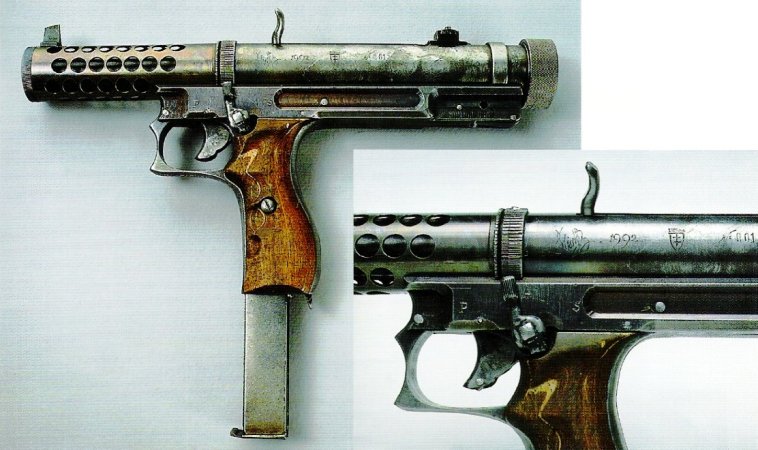
Historic Photos
Browning water-cooled machine gun
Lithuanian soldiers man a Browning machine gun; the soldier on the left feeds ammunition while the one on the right spots the target
A Lithuanian machine gun squad poses with a Browning machine gun and FN rifles
Maxim machine gun
A Lithuanian machine gun squad armed with a Russian M1910 Maxim machine gun, FN and German Mauser rifles
PISTOLS
Immediately after gaining independence, the new Lithuanian military armed its officers and cavalrymen with Russian M1895 Nagant revolvers, or German Model 1908 Luger pistols. [9 ] As time passed, new pistols were purchased for the army under contract.
Known (and Alleged) Lithuanian Pistol Contracts
Gaidis does not believe that these specimens are legitimate:
"There are [a handful] of these on the market. I have never found a Lithuanian Army Veteran who ever heard of these, there is no Lithuanian documentation that they ever existed, and they did not surface until some time in the 1960's when many things were being faked.... If you ever collected Confederate weapons, you know how easy a CS, CSA, or CSN can be added. This is an example of the Pillars being added to a German weapon during the post war period."Lithuanian-marked Nagant revolvers have also been seen for as much as $1750 (Fall 2002). All observed specimens came from the Muller collection.
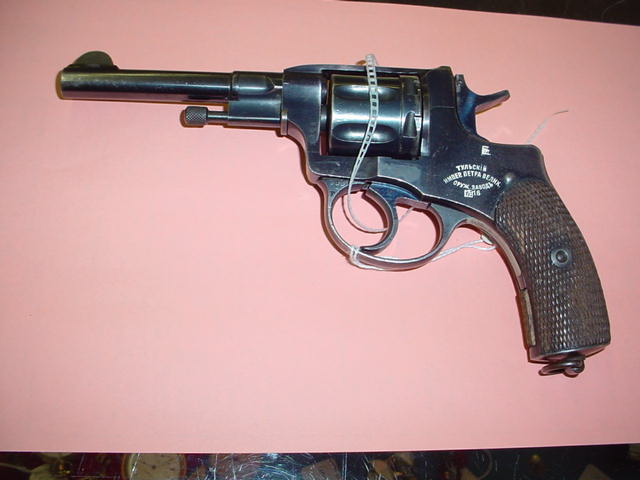
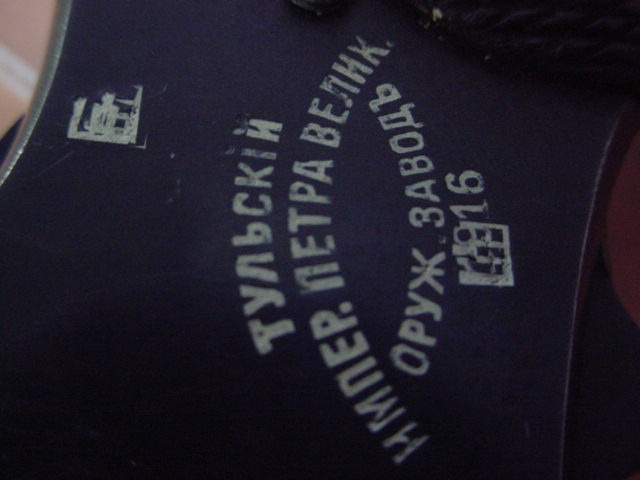
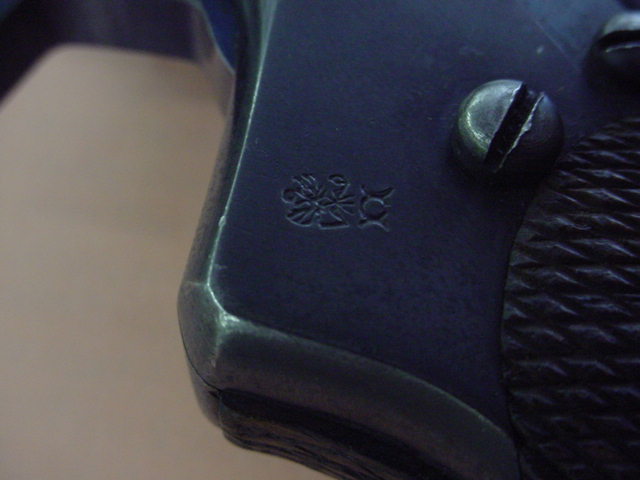
As with the aforementioned Lugers, Gaidis alleges
that these are faked markings.
The Lithuanian army did use use Nagant pistols, in addition to German model 1908 Lugers, 1910 Mauser pistols, and German Broomhandle pistols. However, such weapons were only given Lithuanian markings if they were sent to the arsenal for repairs (and then, only the repaired piece was stamped).
The jury is still out on these Lithuanian-marked Nagants, although it does seem quite fishy that they all seem to have made their first appearance in the same person's collection.
Photos of a late 1930's Lithuanian Browning appear below. Note also that the Lithuanian army has employed the Browning Hi-Power in more recent times. Like the the original models, these are marked with the Pillars of Gediminas [ 6 ]. Additional Browning photos can be seen here
Photos courtesy of Collectible Firearms and Edged Weapons, which is (as of January 2006) offering this specimen for sale at $3500.
Historic Photos
Luger pistol
Lithuanian soldiers armed with Luger 1909 pistols
Miscellaneous pistols
A Lithuanian soldier poses with what appears to be a Becker & Holland Beholla pistol, or later derivative (e.g., a German Stenda, or Menz/Menta pistol)
Modern Pistols
The current sidearm of the Lithuanian Army is the ever-reliable CZ 75. These pistols are marked with the Pillars of Gediminas on the side.
Coming soon: A discussion of the recently-seen Lithuanian Police-marked FEG Hi Powers in .40S&W. In summary, these were a result of a failed contract between Lithuania and FEG. As they were never used, all specimens (which were imported by SSME Deutsche Waffen, and sold by both the latter and SOG in 2002-2003) are in unissued condition (NIB). Photos appear below.
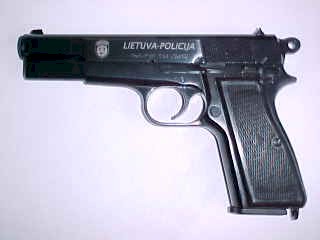
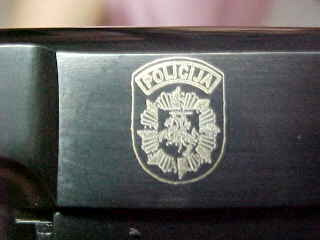
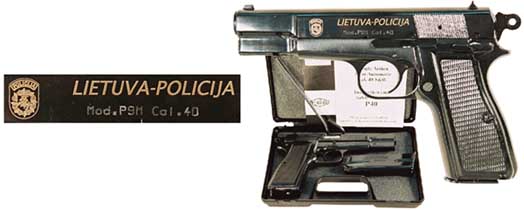
Note: Linas
reports that, as of October 2002, the Lithuanian Police currently use the
CZ 75, CZ 75 Compact, CZ 85, CZ 100, CZ 110, Glock 17, Glock 17C, Glock
17L, Glock 19, HK USP, HK USP Compact, Walther P99, Sig Sauer P226, Sig
Sauer P229, Sig Pro, and several Russian models. Of these, only
the CZ 75's are marked with the Pillars of Gediminas. No Lithuanian
markings appear on any of the others. Thanks Linas!
Note: According to a November 2006 press release from the Lithuanian Police Commissioner, Lithuanian police have updated all their old Makarov pistols to Glock 17 and Glock 19 pistols.
MISCELLANEOUS
Serial Number Data
Some FN pistol and rifle serial numbers are listed here
.
Links of Interest
Firearms
of the Hussars of the Polish-Lithuanian Commonwealth, 1570-1750
A summary of Lithuania's Independence Wars and the procurement of equipment during said wars can be found at Lithuanian Armed Forces of the Independence Wars .
An overview of various Lithuanian armaments can be found at Lithuanian Armor.
For information on the weapons of the Lithuanian police, visit this page. (Sadly, this site seems to be gone for good; maybe it can be found in a cache somewhere?)
For information the rifles of Estonia (another Baltic nation), visit this page.
Email the Author
The author of this page can be reached at webmaster-at-freeexistence.org. Replace "-at-" with "@" in the "To:" line.
References
[ 1]: Ball, R.W.D. (2000). Mauser Military Rifles of the World , 2nd Edition. Wisconsin: Krause Publications. ISBN: 0-87341-828-X.
[ 2]: Military Rifle Journal article from April 1999 (Link presently down)
[ 3]: Walter, J. (1998). Rifles of the World, 2nd Edition. Wisconsin: Krause Publications. ISBN: 0-87349-202-1.
[ 4]: Email correspondences with Bob Rapp.
[ 5]: Email correspondences with John Wall.
[ 6]: Email correspondences with Henry L. Gaidis.
[ 7]: Hogg, I., & Weeks, J. (1992). Pistols of the World, 3rd Edition. Illinois: DPI Books. ISBN: 0-87349-128-9.
[ 8]: Berger, R.J. (1989). Know your Czechoslovakian Pistols. Arizona: Blacksmith Publishers.
[ 9]: Gaidis, H.L. "Lithuanian Military Arms", The Gun Report, January 1981.
